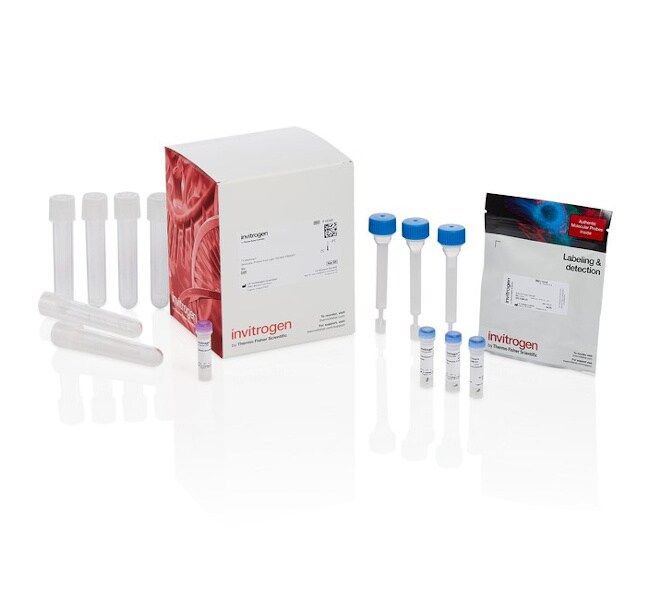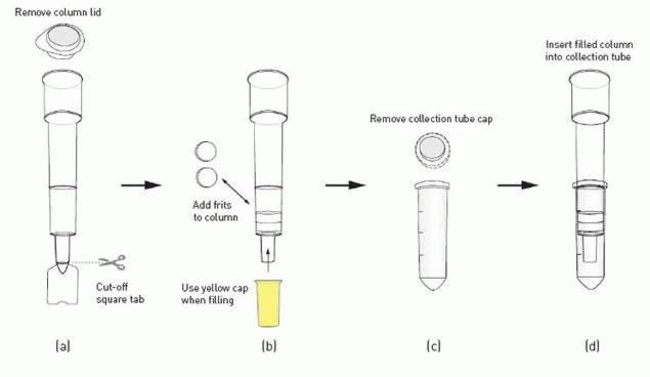
Ready to use in just 90 minutes, our protein labeling kits include an easy-to-use, pre-packed spin column for rapid dye removal and typical recovery greater than 85%. Each kit contains enough reagent for 3–5 protein conjugation reactions. Our kits provide better results due to lower background fluorescence, less nonspecific binding, and easier workflows for protein conjugation with 16 different fluorophores.
Each protein labeling kit contains everything you need to perform 3-5 separate labeling reactions and purify the resulting conjugates. The reactive dye has either a succinimidyl ester (SE) or a tetrafluorophenyl (TFP) ester moiety that reacts efficiently with primary amines of proteins to form stable dye–protein conjugates. Each of the vials of reactive dye provided in the kit is sufficient for labeling 1 mg of a variety of purified proteins, including growth factors, cytokines, nanobodies, enzymes, cell-adhesion molecules, and antibodies.
Direct labeling with fluorophores allows multiple primary antibodies of the same isotype (derived from the same species) to be used in the same experiment. Stabilizing proteins such as BSA should be removed from the sample before labeling.
The different protein labeling kits
For labeling smaller amounts of antibodies (∼100 μg), we recommend our antibody labeling kits. Please review the protein labeling kit user manual for more in depth information, protocols, molecular weights, and degree of labeling for each dye.
| Code | Description |
|---|---|
| A10235 | Catalog Number: A10235 Unit Size: 1 kit Description: Alexa Fluor™ 488 Protein Labeling Kit |
| A10170 | Catalog Number: A10170 Unit Size: 1 kit Description: Alexa Fluor™ 350 Protein Labeling Kit |
| A10236 | Catalog Number: A10236 Unit Size: 1 kit Description: Alexa Fluor™ 532 Protein Labeling Kit |
| A10237 | Catalog Number: A10237 Unit Size: 1 kit Description: Alexa Fluor™ 546 Protein Labeling Kit |
| A20174 | Catalog Number: A20174 Unit Size: 1 kit Description: Alexa Fluor™ 555 Protein Labeling Kit |
| A10238 | Catalog Number: A10238 Unit Size: 1 kit Description: Alexa Fluor™ 568 Protein Labeling Kit |
| A10239 | Catalog Number: A10239 Unit Size: 1 kit Description: Alexa Fluor™ 594 Protein Labeling Kit |
| A20170 | Catalog Number: A20170 Unit Size: 1 kit Description: Alexa Fluor™ 633 Protein Labeling Kit |
| A20173 | Catalog Number: A20173 Unit Size: 1 kit Description: Alexa Fluor™ 647 Protein Labeling Kit |
| A20171 | Catalog Number: A20171 Unit Size: 1 kit Description: Alexa Fluor™ 660 Protein Labeling Kit |
| A20172 | Catalog Number: A20172 Unit Size: 1 kit Description: Alexa Fluor™ 680 Protein Labeling Kit |
| F10240 | Catalog Number: F10240 Unit Size: 1 kit Description: Fluorescein-EX Protein Labeling Kit |
| O10241 | Catalog Number: O10241 Unit Size: 1 kit Description: Oregon Green™ 488 Protein Labeling Kit |
| P30012 | Catalog Number: P30012 Unit Size: 1 kit Description: Pacific Blue™ Protein Labeling Kit |
| D20655 | Catalog Number: D20655 Unit Size: 1 kit Description: DBS-X™ Biotin Protein Labeling Kit |


